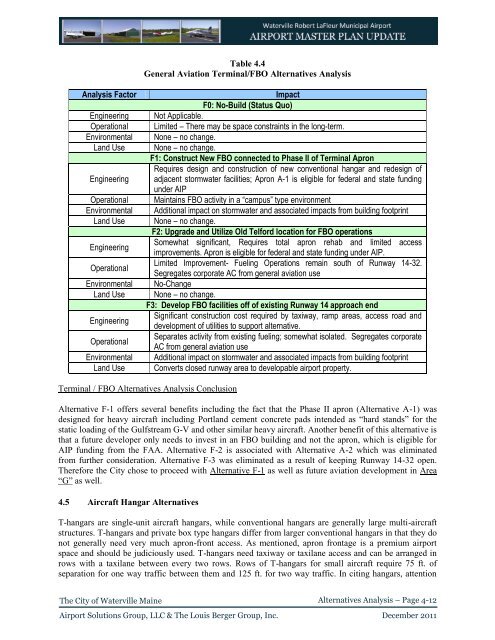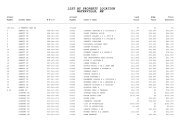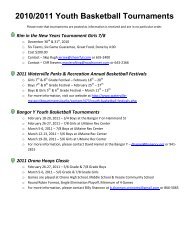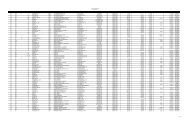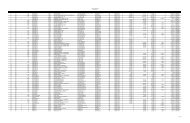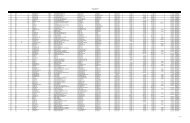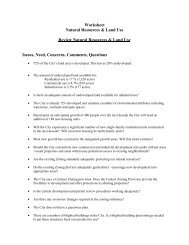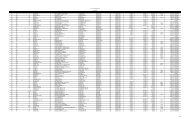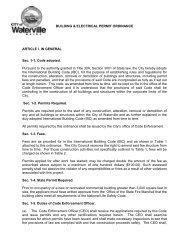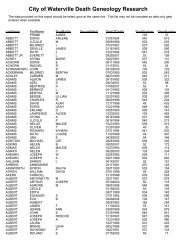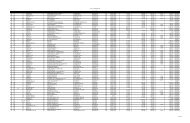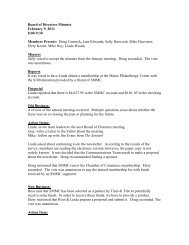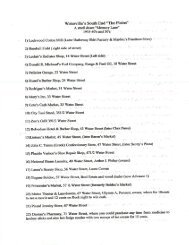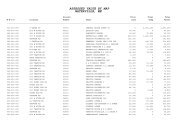Airport Master Plan 2012 - City of Waterville
Airport Master Plan 2012 - City of Waterville
Airport Master Plan 2012 - City of Waterville
You also want an ePaper? Increase the reach of your titles
YUMPU automatically turns print PDFs into web optimized ePapers that Google loves.
Table 4.4<br />
General Aviation Terminal/FBO Alternatives Analysis<br />
Analysis Factor<br />
Engineering<br />
Operational<br />
Environmental<br />
Land Use<br />
Engineering<br />
Operational<br />
Environmental<br />
Land Use<br />
Engineering<br />
Operational<br />
Environmental<br />
Land Use<br />
Engineering<br />
Operational<br />
Environmental<br />
Land Use<br />
Impact<br />
F0: No-Build (Status Quo)<br />
Not Applicable.<br />
Limited – There may be space constraints in the long-term.<br />
None – no change.<br />
None – no change.<br />
F1: Construct New FBO connected to Phase II <strong>of</strong> Terminal Apron<br />
Requires design and construction <strong>of</strong> new conventional hangar and redesign <strong>of</strong><br />
adjacent stormwater facilities; Apron A-1 is eligible for federal and state funding<br />
under AIP<br />
Maintains FBO activity in a “campus” type environment<br />
Additional impact on stormwater and associated impacts from building footprint<br />
None – no change.<br />
F2: Upgrade and Utilize Old Telford location for FBO operations<br />
Somewhat significant, Requires total apron rehab and limited access<br />
improvements. Apron is eligible for federal and state funding under AIP.<br />
Limited Improvement- Fueling Operations remain south <strong>of</strong> Runway 14-32.<br />
Segregates corporate AC from general aviation use<br />
No-Change<br />
None – no change.<br />
F3: Develop FBO facilities <strong>of</strong>f <strong>of</strong> existing Runway 14 approach end<br />
Significant construction cost required by taxiway, ramp areas, access road and<br />
development <strong>of</strong> utilities to support alternative.<br />
Separates activity from existing fueling; somewhat isolated. Segregates corporate<br />
AC from general aviation use<br />
Additional impact on stormwater and associated impacts from building footprint<br />
Converts closed runway area to developable airport property.<br />
Terminal / FBO Alternatives Analysis Conclusion<br />
Alternative F-1 <strong>of</strong>fers several benefits including the fact that the Phase II apron (Alternative A-1) was<br />
designed for heavy aircraft including Portland cement concrete pads intended as “hard stands” for the<br />
static loading <strong>of</strong> the Gulfstream G-V and other similar heavy aircraft. Another benefit <strong>of</strong> this alternative is<br />
that a future developer only needs to invest in an FBO building and not the apron, which is eligible for<br />
AIP funding from the FAA. Alternative F-2 is associated with Alternative A-2 which was eliminated<br />
from further consideration. Alternative F-3 was eliminated as a result <strong>of</strong> keeping Runway 14-32 open.<br />
Therefore the <strong>City</strong> chose to proceed with Alternative F-1 as well as future aviation development in Area<br />
“G” as well.<br />
4.5 Aircraft Hangar Alternatives<br />
T-hangars are single-unit aircraft hangars, while conventional hangars are generally large multi-aircraft<br />
structures. T-hangars and private box type hangars differ from larger conventional hangars in that they do<br />
not generally need very much apron-front access. As mentioned, apron frontage is a premium airport<br />
space and should be judiciously used. T-hangars need taxiway or taxilane access and can be arranged in<br />
rows with a taxilane between every two rows. Rows <strong>of</strong> T-hangars for small aircraft require 75 ft. <strong>of</strong><br />
separation for one way traffic between them and 125 ft. for two way traffic. In citing hangars, attention<br />
The <strong>City</strong> <strong>of</strong> <strong>Waterville</strong> Maine<br />
Alternatives Analysis – Page 4-12<br />
<strong>Airport</strong> Solutions Group, LLC & The Louis Berger Group, Inc. December 2011


